Hugh Montgomery
This is all the information I have at present on my Great Grandfather Hugh Montgomery. He died aged 38 on 16th July 1916 during the Battle of the Somme in Northern France leaving a wife, Mary Ann (Moore) Montgomery and four young children, Freda, Hugh, Harry and Richard. He was hit in the stomach by a shell fragment whist working at night to clear the white chalk soil from the entrance to sappers mines that were being dug under the German trench line. He was taken to the Bethune Military hospital where he died of his wounds. He is buried in the Bethune Military cemetery.
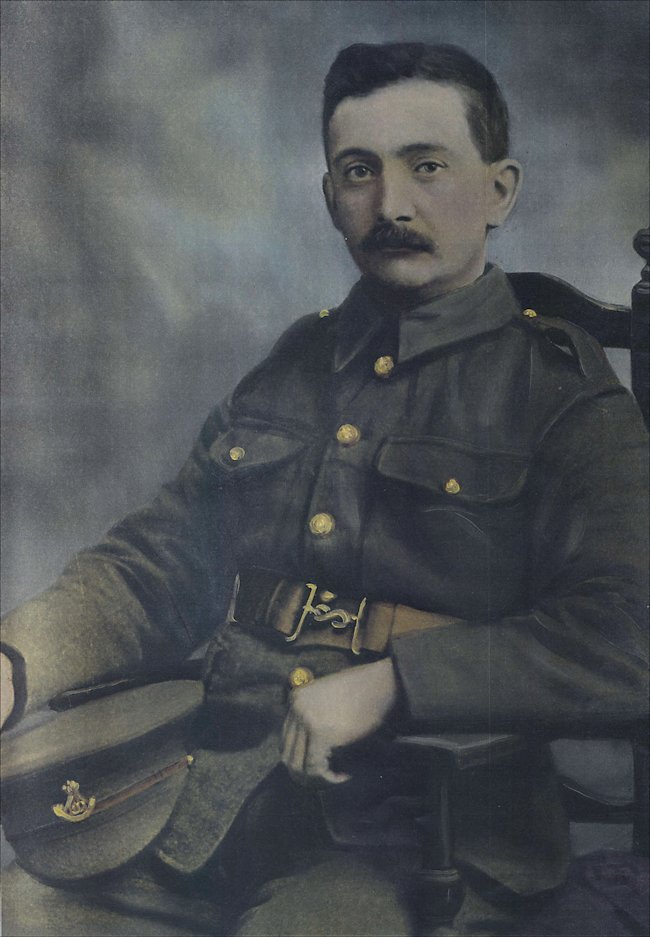
Hugh Montgomery, Private 22/286 22nd Battalion (Pioneer Corps) Durham Light Infantry 1916
Hugh was born 10th July 1877, 1 Gillespie Lane, Port Glasgow, Scotland. His father, also called Hugh Montgomery, worked in the shipyards in Port Glasgow. The 1901 Census shows at the age of 23 he was a shipwright, like his father working in the Port Glasgow shipyards. A shipwright is a carpenter skilled in ship construction and repair.
He moved to 15,Dover Street, West Hartlepool, north east England. He lived there with his wife Ann Moore. On 6th August 1915, the Durham Parliamentary Recruiting Committee was asked by the War Office to raise a battalion of Pioneers. Enlistment of the 22nd Battalion (Pioneer Corps) Durham Light Infantry began on 1st October 1915, just over a year since the start of the war. Hugh Montgomery was the 286th volunteer. He was a skilled man as had worked in the shipyard and for the railway company building railway coaches. Pioneers got a better wage than infantry during the First World War as they normally all had skills in engineering, construction or demolition.
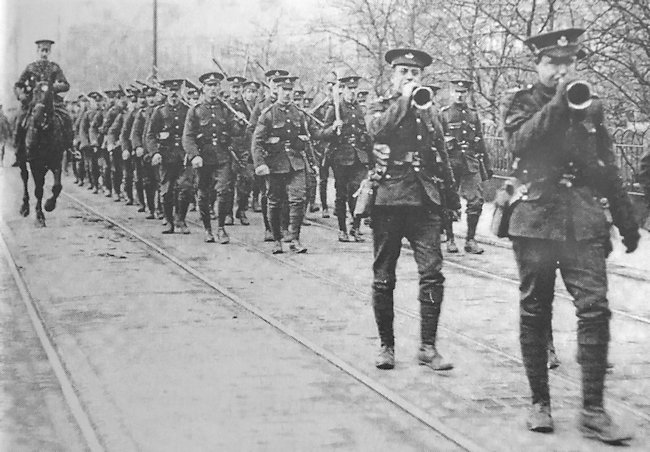
Durham Light Infantry Pals in training whilst stationed at Cocken Hall near Durham, Autumn 1914.
The Battalion remained in West Hartlepool until 21st March 1916 when it moved to Catterick Bridge. On 16th June 1916, led by Lt. Colonel C.B.Morgan, it moved to Southampton where it crossed the Channel and landed in Le Havre, Northern France. The train took the Battalion straight to the Somme area, Frechencourt, about two miles north of the Albert-Amiens road. This was the sight of the first camp. On the 20th June 1916 they moved northwards to Bavelincourt.
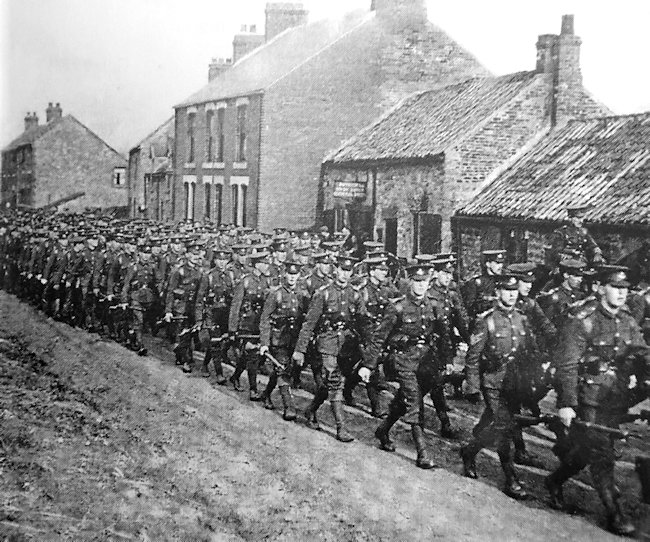
Durham Light Infantry Pals recruits marching off to war 1916
The 22nd Battalion was attached to the 8th Division. On the 23rd June 1916 all available battalion officers were sent up for their first experience of the trenches. They visited the front line just east of Albert. The men were busy unloading ammunition and repairing roads until they moved forward to Millencourt, on the 30th June 1916. It was a long march. 'A' Company remained in reserve at Millencourt whilst 'B' 'C' and 'D' companies moved forward through Albert. Their orders were to consolidate and hold the ground won by the infantry attack of the 8th Division around the villages of Ovillers and La Boisselle.
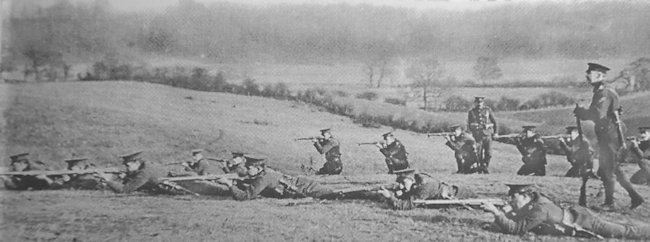
Rifle practice for the new recruits to the Durham Light Infantry.
The next day they had to bring up stores and bring back wounded. At night a party of 100 men established a dump in the captured German trenches near La Boisselle. Early the next morning they were relieved by the 5th South Wales Borderers and in the evening of 3rd July 1916 the Battalion left Millencourt as the 8th Division were withdrawn from the line. Five pioneers had been wounded. Was one of these Pioneers Hugh Montgomery? I cannot find out. Most of the records of service for First World War soldiers were largely destroyed by bombing in the Second World War. The Battalion then marched to Amiens and got into cattle trucks to be moved to their next deployment. This is as far as I have been able to go.
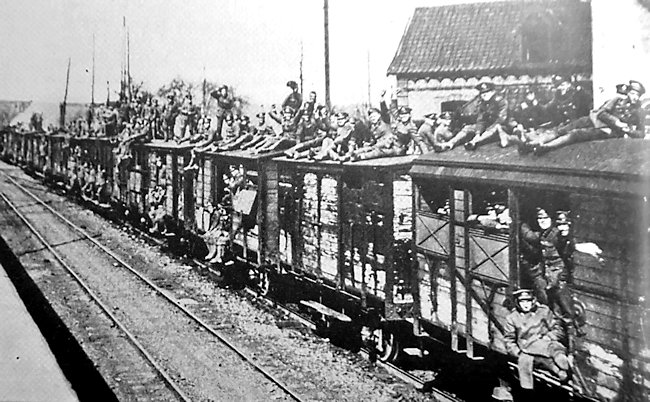
Troop trucks heading towards the Somme 1916
The following account was written by Hugh Montgomery's officer, Major T.G.Davidson, 22nd Battalion (Pioneer corps) Durham Light Infantry, 'On we went at a slow speed past Rouen and Amiens, both of which I recognised by their great churches. After about 24 hours we reached a small obscure place, which if I remember rightly was Freisline court. The train stopped. Here we had our first casualty, but hardly one that occurred 'in action'. One of our Company Commanders seizing his freshly de-trained charger to eagerly, the horse swerved and slipped upon an iron plate let in the ground to fall heavily, crushing the officers foot severely. Not till ten months later could he rejoin us! However, this did not distress us greatly for though an amusing man he was difficult to take quite seriously.'
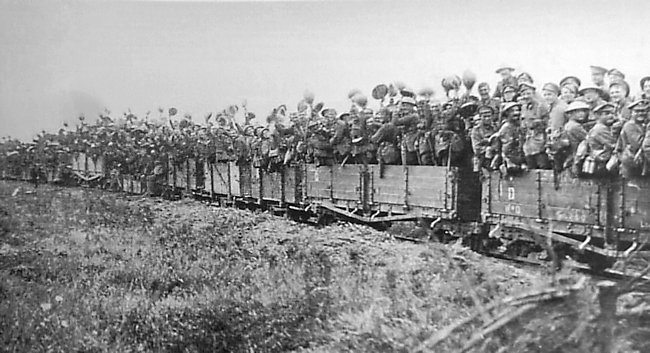
Durham Light Infantry troops being transported in light railway trucks
'We marched a mile or two to billets in a small village. The ranks had barns, byres and sheds lately occupied by other troops who left them littered with rifle ammunition. Of this we gathered up a quantity in sandbags and bestowed on our transport. New Brooms!'
'A day later 'A' Company marched off, under a junior major, for a fatigue duty unloading shell at some railhead. Although we were some miles in front of Amiens, it was only at night that we could fear gunfire and see flashes from their muzzles against the dark sky, The weather was delightful and we spent a few days overhauling stores and issuing out a number of shovels and picks for it seemed likely we should be employed under the Royal Engineers in reconstructing trenches etc. After the great attack(which everyone knew was immanent) had made a forward advance.'
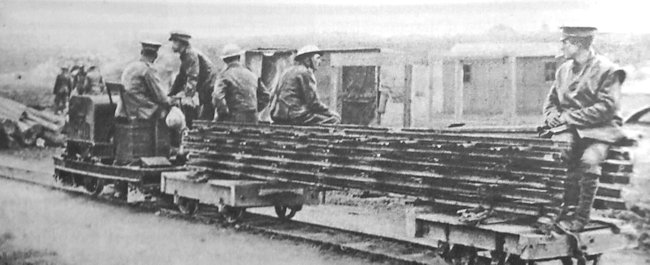
DLI Pioneers laying more track for the light railway
'On one of these days the Commanding Officer took up the bulk of us officers for a tour of inspection of the front where we were to go in. For this purpose an old London Omnibus was provided and a jolly ride it was over the white chalk roads of Picardy in La Belle France. Very soon however the countryside was deserted of civilians to be replaced by huge ammunition dumps, veterinary corps and what not. Then we saw a few cemeteries. At length we came in sight of the Virgin leaning at right angles from the tower of Albert Cathedral.'
'At the outskirts of that shattered town we debussed. The Colonel taking one party, left me to conduct the remaining officers through the town, up a communication trench called St Andrews' Avenue to the support line where there were certain redoubts (strongholds). On the way up we passed batteries of field guns firing desultory. We spent about three hours in various parts of the trenches. We heard the whistle of an occasional rifle bullet, still it was quiet on the whole. The temperature was insufferably close until a great thunder storm broke over head. We were not as used to a drenching as we were to become!'
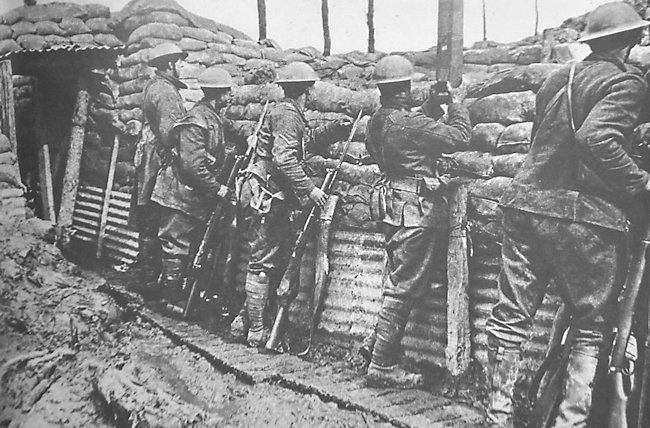
Durham Light Infantry troops in a reserve line stand to.
'Two days later at dawn, it being the first of July 1916, we went up in earnest, three companies strong, my company leading. As we entered Albert, a great gun, possibly a twelve incher, fired from a railway cutting below us. This was the first we had heard and seen of such monsters; the result was certainly surprising. We were still wearing the ordinary cloth cap, all other troops had iron helmets affectionately known as the 'tin hat.'
'We got safely to the forward edge of the town to deploy in our allotted positions behind a line of field batteries in advance of some vacant warehouse and brewery. Here there were some shelter trenches; our field cookers and water carts I parked in a convenient ruin of a warehouse in our rear. Nevertheless a cook of my company was our first casualty in action; he received a stray bullet in the thigh.'
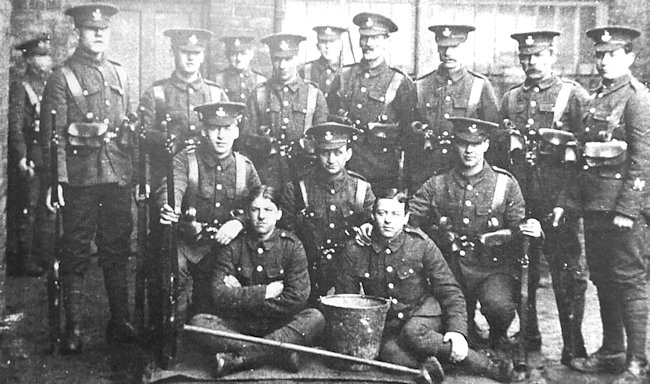
One section, 4 Platoon A Company 22/Durham Light Infantry, Hartlepool 1915.
'Occasionally the enemy guns retaliated upon our batteries, thus our men were getting their baptism of fire especially when shells, pitching beyond their objective, showered us with earth. It was not severe and most of us seemed to enjoy the experience, for all our men were in good spirits and fettle. '
'La Boiselle was just to the left of our front and at first report and rumour that reached us was of great successes, though actually it proved that all the British left attack had been pretty well 'washed out' with huge casualties from flank machine gun fire directed from Thienville. At dusk I was commanded to send one company up carrying barbed wire and pickets to consolidate and reinforce the trenches captured from the enemy by a battalion of the Tyneside Scottish. This I did personally, crossing what had so lately been No-mans Land. It could be seen even in the dark that here the land lay rather lower and was sheltered from the flank that had shattered so many of our service battalions that went over on the left.'
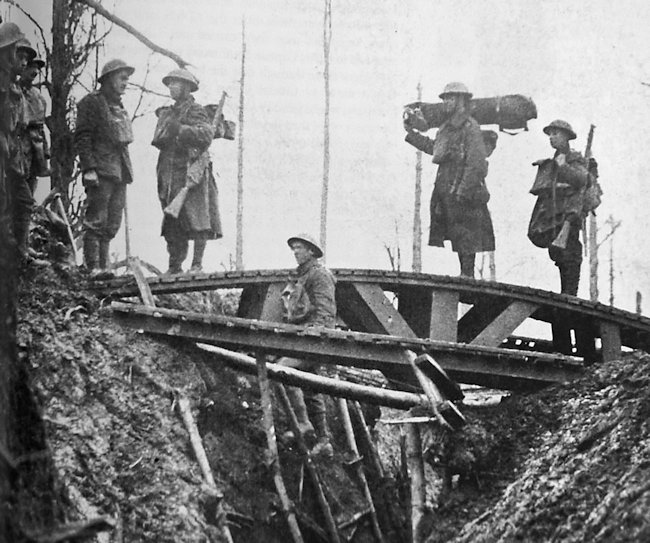
DLI Pioneers finish building a bridge over an old German Trench
'After an hour I made my way back to my advanced headquarters leaving the company in charge of Captain B with orders to retire before dawn unless otherwise directed. I came back with a group of our stretcher bearers bringing back some wounded Tyneside Scottish officers and men.'
'It was well I did come back for at 2am the colonel arrived with further commands to deploy a company in our front line, for an enemy counter attack was believed possible. Other parties drawn from the remaining company were to evacuate wounded. Digging out a blown in trench shelter a man was blinded when his shovel struck an unexploded bomb.'
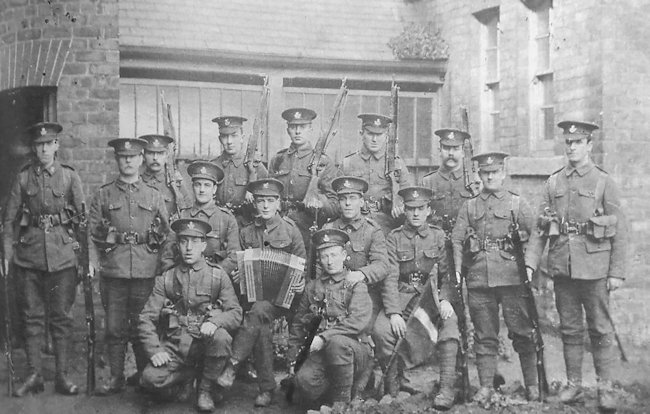
3 Section, C Company 22/Durham Light Infantry.
'Towards dawn heavy masses of infantry of another division marched up into the trench, no doubt they were to go over the top that day. I got a message to retire all Durhams. This was not difficult until we were half way back to Albert; heavy stuff was dropping about our forward gun positions and I observed that a warehouse, adjoining the one we used as a cook house had collapsed.'
'.....Our casualties were not heavy, infact trifling compared with other units, but we had had a good fair test, including moving in darkness under fire. A few days continued on very similar lines and it soon became evident to me that we were not to be deployed in the main assault. On the last day of the opening of the Battle of the Somme we were deployed on rescue missions around La Boiselle. Here the infantry had been terribly cut up by machine gun fire. We got out eighteen men and one officer, all the others were dead.'
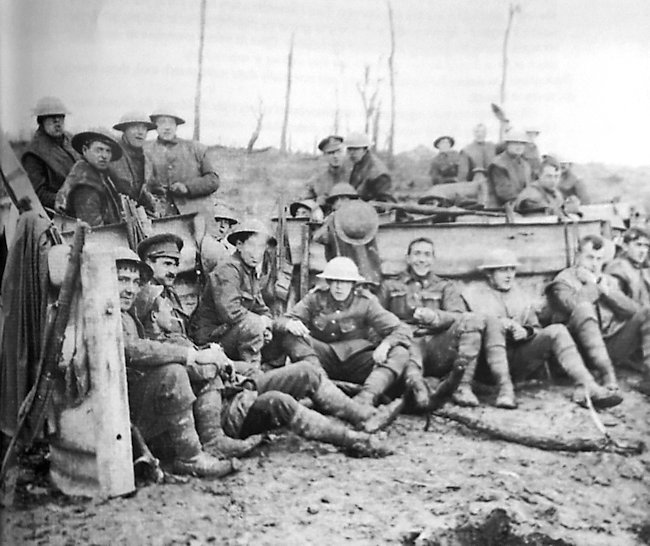
Men of 22/Durham Light Infantry take a break from work on the Somme battlefield 1916
'Passing the H.Q. of this battalion I reported to their commanding officer. He greeted me hopefully, but became speechless with grief, his eyes full of tears. He had hopped that many others were alive.'
'That night we got the order to march out. Our three companies went in six hundred strong and came out five hundred and seventy-five. Nearly half of us had acquired 'tin hats' gathered off the field from those poor fellows, who having born the brunt of the day and paid the price, would want them no more'
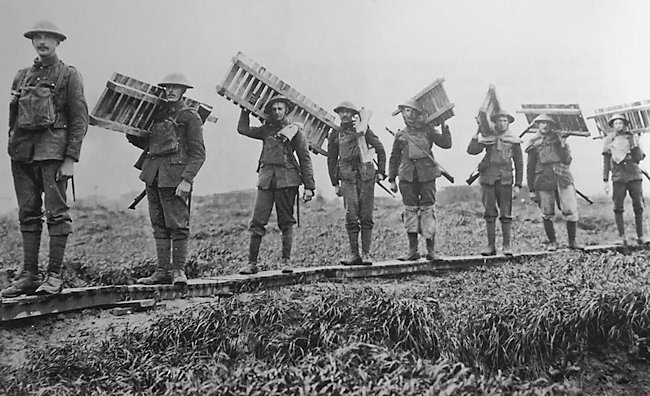
Pioneers carrying wooden duckboards to extend the footpath over muddy ground.
'So out merrily along the roads with our band playing the 'Merseillaises',the French National Anthem as we trudged along the dusty roads and through small towns. The playing called out the shopkeepers and their customers to see us. A day or two in bell tents and then a forced march to Amiens where we got into some cattle trucks ...'
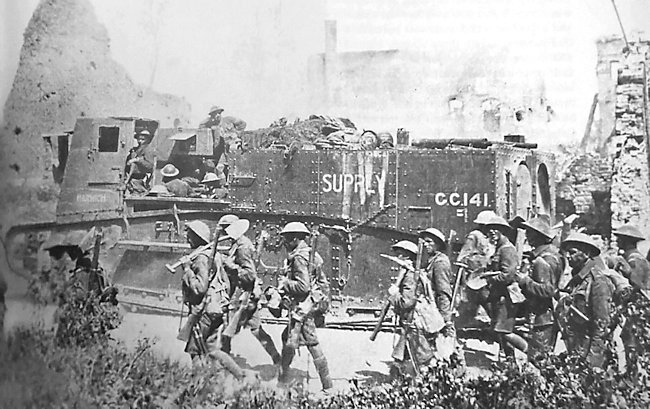
Armoured supply tank taking equipment and stores to the front line with Pioneers marching by the side.
Bethune WW1 Military Hospitals
During WW1 Bethune's General Hospital could not cope with all the injured men coming from the western front. Two more buildings were commandeered and made into WW1 British military hospitals, both were schools: the College Saint Vaast and the College de Garcons. I do not know which one my great granddad Hugh Montgomery was sent to. He would have arrived by train from the front and then transported to one of these buildings. I have not been able to find out which one.
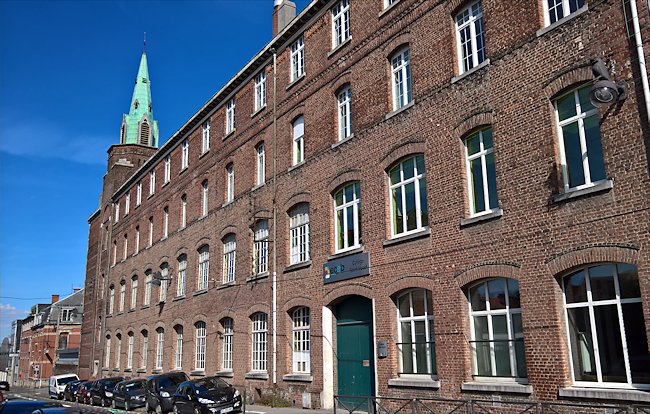
The side entrance to the College Saint Vaast that was used as a WW1 Military Hospital, Rue Faidherbe, Bethune, France
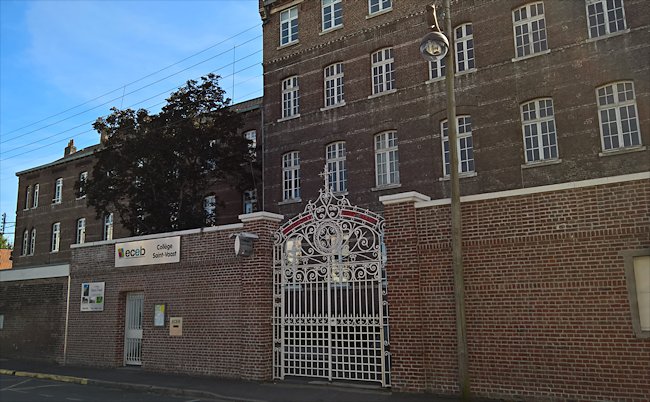
The main gated entrance to the College Saint Vaast, Rue Paul Doumer, Bethune, France. It was used as a WW1 British Military Hospital
College Saint Vaast WW1 Military Hospital Rue Paul Doumer at the junction with Rue Faidherbe in Bethune, France - The hospital set up in this school started treating wounded Indian soldiers in November 1914. In September 1915 the 33rd Casualty Clearing Station (CCS) moved in. Throughout the war the school suffered regular shelling which led to evacuations in May 1915 and June 1916. Of the facilities installed in the school were a well-equipped operating room, a laboratory of microbiology and an X-ray room. Many great names in the field of medicine did stints in the hospital. There were also dormitories for the wounded and comfortable washrooms which received up to 800 men per day. The students remained in the school and, from their sleeping quarters in the basement, could hear the wounded soldiers crying out in pain.
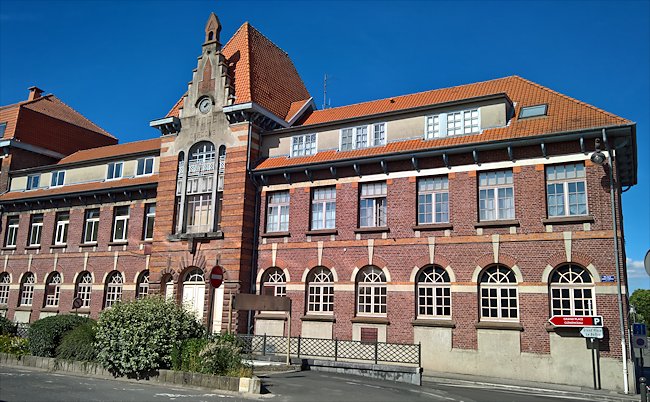
The main entrance to the College de Garcons, Place Clemenceau in Bethune. It used to be a WW1 Military Hospitals in France
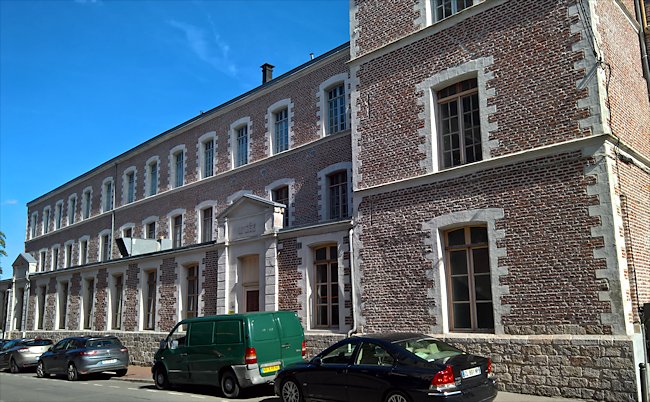
The rear entrance to the College de Garcons, Rue Edouard Herriot in Bethune, France. It was a Military Hospital during WW1
College de Garcons, Place Clemenceau at the junction with Rue Edouard Herriot, Bethune, France WW1 Military Hospital - Run by the Union des Femmes Francaises, an organization similar to the Women's Institution, the boys' school served as an auxiliary hospital with 50 beds in 8 August 1914. Heavy shelling forced its closure three months later. The hospital was recommissioned by the British Army on 6 October 1 915. The pupils had to live alongside the wounded soldiers and were trained how to act in times of danger. Issued with electric torches, they would take shelter in the cellar and knew how to use a gas mask. The boys were eventually moved to Bruay-en-Artois in August 1916 and their former dormitories were used to billet British troops for the rest of the war.
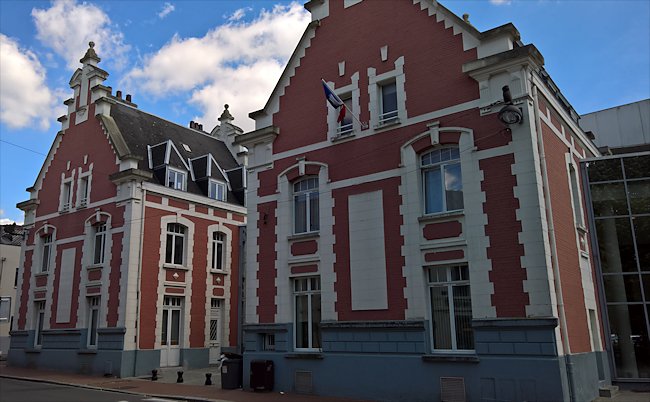
The restored fašade of the bomb damaged Military WW1 General Hospital in Bethune in France
The Military WW1 General Hospital, Rue Ludovic Boutleux at the junction with Rue Georges Pompidou in Bethune in France - The General Hospital treated both civilians and soldiers of various nationalities (British, French and German). Because of the continual shelling, the wounded were sent to Saint-Omer and Berck-sur-Mer unless their condition meant that it was too dangerous to move them. Those who remained were cared for by the doctors and Franciscan nuns. The hospital was evacuated in 1917 and remained closed until April 1919. Two buildings of the old hospital are still visible on Rue Boutleux. Saint Pry Chapel is more recent, dating from the post-war reconstruction.
Newspaper reports
There is an entry in the Northern Daily Mail dated Thursday 20th July 1916
Births Marriages and Deaths
Killed In Action
MONTGOMERY - Died of wounds on 16th July 1916 Pte. H Montgomery, D.L.I. aged 38 Dearly beloved husband of Mary Montgomery (nee Moore) of 15 Dover Street - He answered his call - His duty done - Deeply Mourned.
MONTGOMERY - Died of wounds on 16th July 1916 Pte. H Montgomery, D.L.I. aged 38. Dearly beloved of Ralph and Mary Moore of 21 Dover Street - He answered his call - His duty done - Deeply Mourned.
There is an entry in the Northern Daily Mail dated Friday 28th July 1916
LOCAL CASUALTIES
Mrs Montgomery 15 Dover Street has received a message of sympathy from the King and Queen on the death of her husband Private Hugh Montgomery, killed in action. Private Montgomery who was formerly a carpenter with N.F.R. Co leaves a widow and five children.
Commonwealth War Graves Commission
Private Hugh Montgomery is recorded as having died of his wounds on 16th July 1916. He is buried in;-
Bethune Town Cemetery,
Row F 94,
Northern France
The cemetery is in the northern section of the town. It is not a military cemetery. It is the town cemetery, but at the far end there is a large Commonwealth Cemetery. Looking at the graves and the position of Bethune to the front line it appears that this cemetery was attached to a military hospital. Most of the well kept graves belong to soldiers from lots of different regiments. In most other Commonwealth Cemeteries you find that most of the graves belong to one regiment.
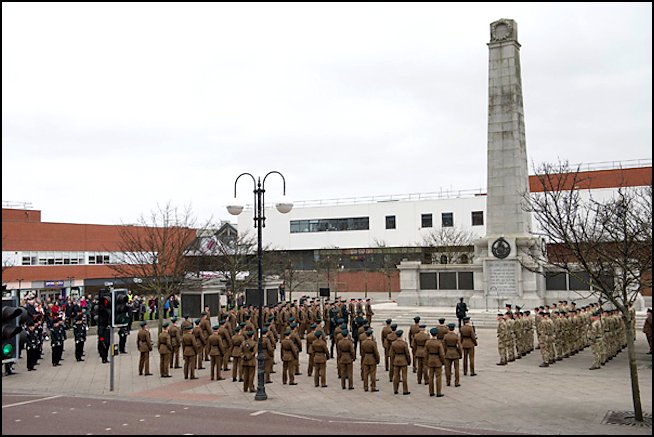
Hartlepool War Memorial Obelisk 1914-18
War Memorial
Private Hugh Montgomery is recorded as having died at the battle of the Somme on the Hartlepool War Memorial Obelisk 1914-18, panel 8, Victory Square, south side of Victoria road at the junction with Avenue Road, West Hartlepool. The Aberdeen granite obelisk was unveiled 11th October 1923. On the northern elevation the inscription reads, 'In grateful remembrance of the men of this town who at their country's call left all that was dear to them to hazard their lives that others might live in Freedom. Their name liveth for evermore. 1,545 names are listed on this memorial.

Hugh Montgomery, Private 22/286 22nd Battalion (Pioneer Corps) Durham Light Infantry 1916